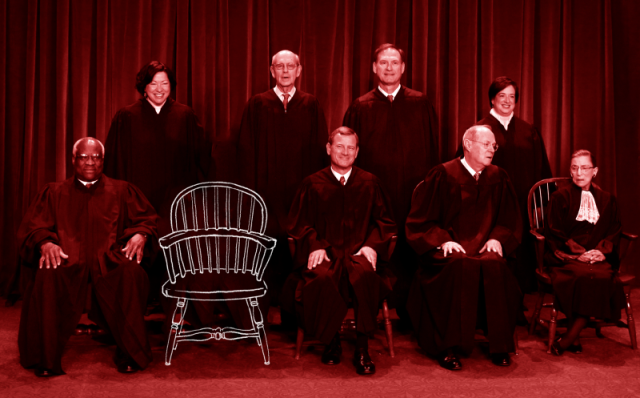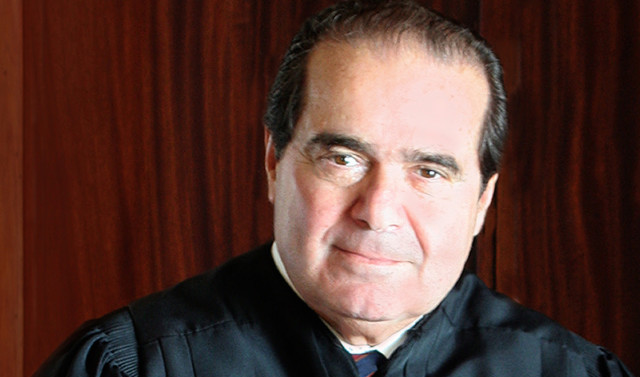Did Justice Scalia Already Give Us the Solution to the Problem of Filling His Seat?
The death of the intrepid Justice Antonin Scalia has shaken the political world. If his successor’s appointment cannot be delayed until the next presidency, it’s assured that an unassailable hard-left majority will control the Supreme Court. This will mean, conservatives warn, the end of significant Second Amendment rights, curtailment of many religious freedoms and a consistent rubber-stamp for the “progressive” agenda.
Unfortunately, the likelihood of replacing Scalia — the court’s pre-eminent legal mind — with even a pale imitation is slim. For it to happen
- the Senate will have to exhibit fortitude and delay the confirmation of a successor.
- a Republican will have to win the presidency.
- the GOP will have to retain the Senate in Nov., and 24 GOP seats but only 10 Democrat ones are up for grabs.
- the Republican president in office will have to nominate someone not a wolf in constitutionalist’s clothing; the chances of this alone happening are likely less than 50 percent.
The probability of all four of the above coming to pass isn’t great. And, regardless, while we will fill the great Scalia’s position, we’ll never fill his shoes. Yet perhaps the real solution to this problem lies with something Scalia himself said — just last year.
The real issue here is not whether Scalia’s successor will abide by the Constitution.
It’s whether we will.
Consider: in a representative republic of 320 million people, we’re all now talking about how one appointment of one unelected lawyer can radically change the face of American law, rights and freedoms. Anything wrong with this picture?
This isn’t to say that a civilization’s fate being radically altered by one man’s death and another’s ascendancy hasn’t been humanity’s norm. Autocracy has been humanity’s norm. The king would pass on and people might lament, “You mean Aylwin, that kid who drools on his cloak, is next in line? How shall we be ruled?” But does this sound like a concern in a land of, by and for the people? The fact is that a government cannot be stable if one man’s fancies and fortunes can have such a great impact on it and the wider society. Did the Founding Fathers — who were most concerned about avoiding the aggregation of power by any one entity — really devise such a flawed system?
This brings us to Scalia’s comment, made in his dissenting opinion in the 2015 Obergefell v. Hodges (marriage) ruling. To wit: with “each decision…unabashedly based not on law” the Court moves “one step closer to being reminded of [its] impotence,” he warned his colleagues. To what was he referring?
Obviously, the Court has neither army nor police to enforce its judgments; it is government’s executive branch — headed by the president on the federal level and governors in the states — with the constitutional warrant to enforce law. And whatever executive branches don’t enforce doesn’t happen, period, no matter how much black-robed lawyers stamp their feet.
But is this just a matter of might makes right? Aren’t we to be a nation of laws? For sure.
A nation of laws, not lawyers.
Laws — not judicial decisions.
There is a difference. Note that Scalia complained of decisions “unabashedly based not on law,” clearly drawing a distinction between decisions and laws. Conclusion? An executive branch upholding illegal decisions is, by definition, not safeguarding the rule of law.
And an executive branch that defies ignores illegal court decisions is preserving the rule of law.
“Defies” is crossed out above because that term can connote resistance to authority. But the Supreme Court is not the Supreme Being. What “authority” over all and sundry does it have? Some will now answer, “Judicial supremacy!” Let’s examine that.
The legislative branch has the power to make law because the Constitution grants it. The executive branch has the power to enforce law because the Constitution grants it. And the courts exercise judicial supremacy — where its decisions constrain not just its own branch but the other two as well, making it not a “co-equal” branch but a super-legislature/über-executive — because ____________?
The answer has nothing to do with the Constitution. Rather, the Supreme Court unilaterally declared the power in the 1803 Marbury v. Madison ruling.
That’s right: Like an upstart seizing the reins in a palace coup, the Supreme Court assigned the Supreme Court its oligarchic power, all without the force of arms. It’s a nice con if you can pull it off.
This isn’t how our system is meant to work. A governmental branch derives its power from the Constitution — not from itself. And how dangerous is this usurpation? Founding Father Thomas Jefferson warned in 1819 that judicial supremacy’s acceptance would do nothing less than make “our constitution a complete felo de se” — a suicide pact. He explained:
For intending to establish three departments, co-ordinate and independent, that they might check and balance one another, it has given, according to this [judicial supremacy] opinion, to one of them alone, the right to prescribe rules for the government of the others, and to that one too, which is unelected by, and independent of the nation…. The constitution, on this hypothesis, is a mere thing of wax in the hands of the judiciary, which they may twist, and shape into any form they please.
Abraham Lincoln, who ignored the Dred Scott decision, also agreed. As Princeton University professor Robert George put it while conducting a December interview with Senator Ted Cruz, Lincoln said “that to treat unconstitutional court rulings as binding in all cases, no matter what, no matter how usurpative, no matter how anti-constitutional, would be for the American people — and I quote now the Great Emancipator — ‘to resign their government into the hands of that eminent tribunal.’” Jefferson was even more pointed, writing in 1820 that judicial supremacy is “a very dangerous doctrine indeed, and one which would place us under the despotism of an oligarchy.” And so it has come to pass. We’re now reduced to arguing about how the next appointed oligarch will shape us wax people.
Satirist Jonathan Swift wrote, mocking the legal profession in Gulliver’s Travels, that it is a maxim among lawyers “that whatever has been done before, may legally be done again…,” no matter how preposterous. Just as bad, however, is when we abide by judicial supremacy again and again, simply because it has been done before. Part of what motivates this deference is ignorance and (bad) habit, and part is cowardice and political expediency. After all, hiding behind unconstitutional court rulings allows politicians to avoid making difficult decisions. When Ohio governor John Kasich said last June after Obergefell that faux marriage is “the law of the land and we’ll abide by it,” he was essentially stating “Hey, don’t look at me. The Court did it!” Of course, he also said that now “it’s time to move on,” which he was more than happy to do. He has got his political career to consider — Constitution be damned.
Any president, governor or legislator worth his salt would do his duty and tell usurpative judges to go pound sand. Some will say that this would set off a “constitutional crisis,” but newsflash: we’re already experiencing a constitutional crisis. This occurs not when the Constitution is protected by bringing to heel those who trample it, but when that trampling goes unanswered.
By the way, you know who else apparently questions judicial supremacy? Barack Obama. He has shown willingness to ignore the courts; in fact, he has been so dismissive that a federal appeals court actually ordered the administration in 2012 to submit a letter stating whether or not it recognized the judiciary’s “power.”
Of course, Obama will defy constitutional laws; in contrast, “conservatives,” being conservative (as in reluctant to take bold action), won’t even ignore unconstitutional rulings. It’s an old story. Liberal-controlled localities have been nullifying (ignoring) federal immigration and drug laws for decades. But conservatives consider nullification — even in the defense of legitimate freedoms — some kind of radical action, despite Jefferson’s calling it the “rightful remedy” for all federal usurpation. And “conservative” justices tend to feel constrained by “precedent,” even the unconstitutional variety, yet don’t expect any liberal Scalia replacement to bat an eye at overturning constitutional precedent that contradicts the leftist agenda. Is it any wonder conservatives never saw a cultural or political battle they couldn’t lose?
One might say conservatives fight by Queensbury rules while liberals operate no-holds-barred, but it’s not even that. Though conservatives are allowed to throw punches, they prefer to stand and block and be a punching bag — while the liberals throw sand in their eyes and kick off their kneecaps.
Calling the Court a “threat to American democracy,” Justice Scalia wrote in his Obergefell dissent, “[I]t is not of special importance to me what the law says about marriage. It is of overwhelming importance, however, who it is that rules me. Today’s decree says that my Ruler, and the Ruler of 320 million Americans coast-to-coast, is a majority of the nine lawyers on the Supreme Court.” We won’t talk the court out of its power-mad, usurpative bent. Only power negates power. It’s time to stop acting like impotent fools and start showing the Court how impotent it really is.
Contact Selwyn Duke, follow him on Twitter or log on to SelwynDuke.com.
RELATED ARTICLES:
What the Constitution Tells Us About Confirming Obama’s Judicial Nominees
Fight to Replace Scalia Proves Supreme Court Has Become Too Powerful
Next President, Not Obama, Should Pick Scalia’s Successor
How Scalia’s Death Will Impact Cases on Immigration, Abortion, Religious Liberty




 To the President and all Presidential Candidates
To the President and all Presidential Candidates













 On Friday, February 12, 2015 CNN
On Friday, February 12, 2015 CNN 

